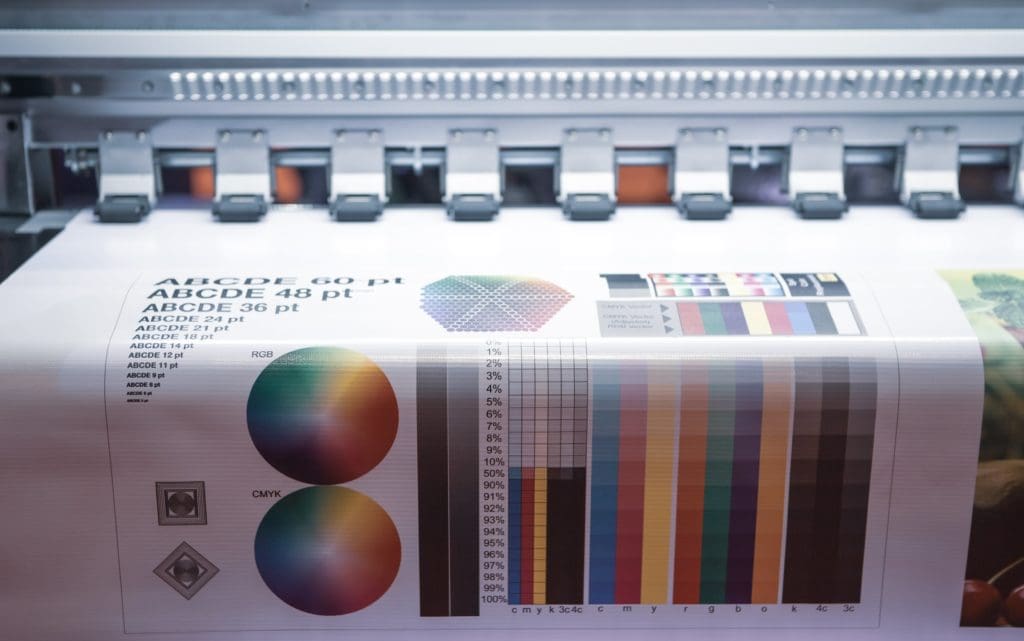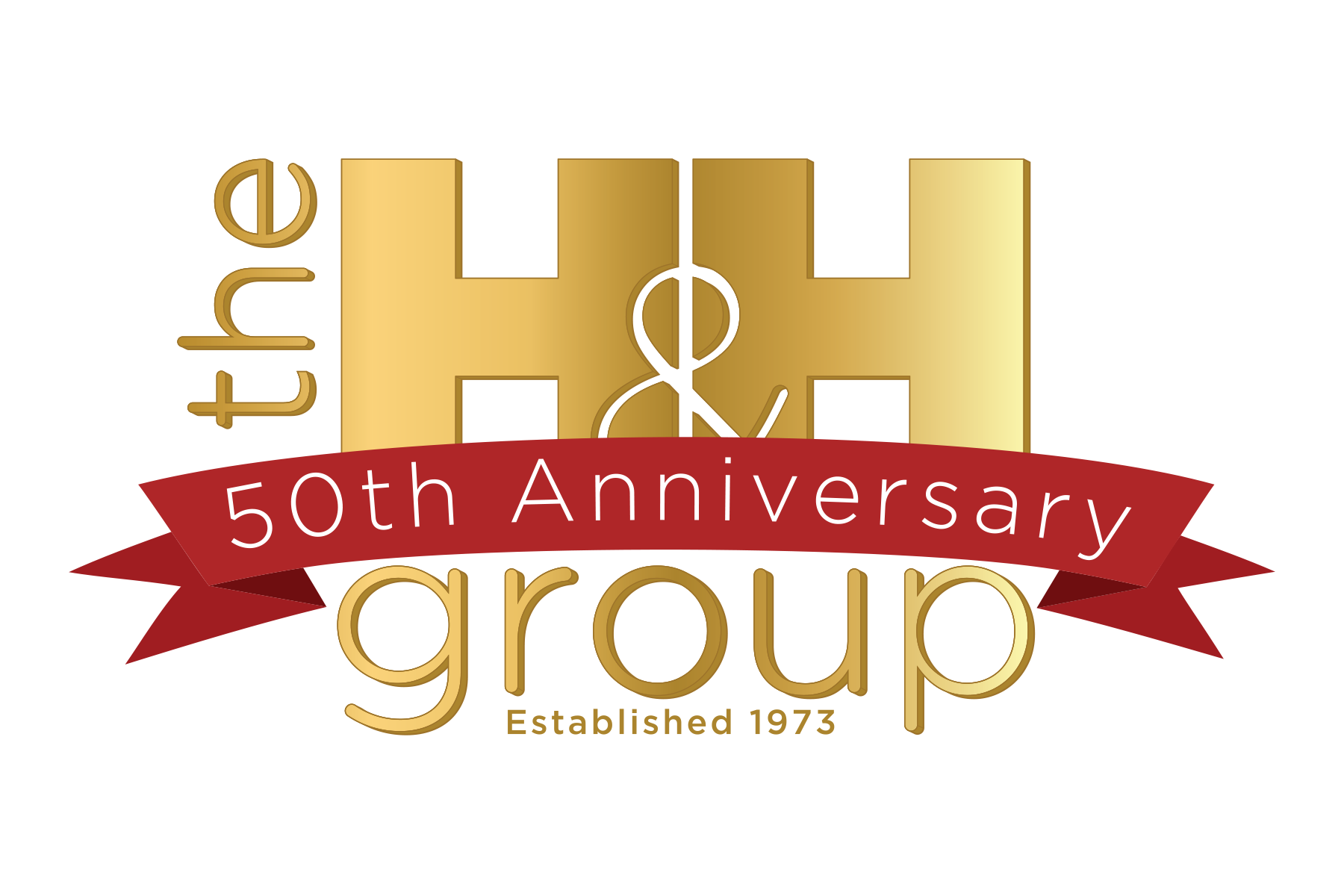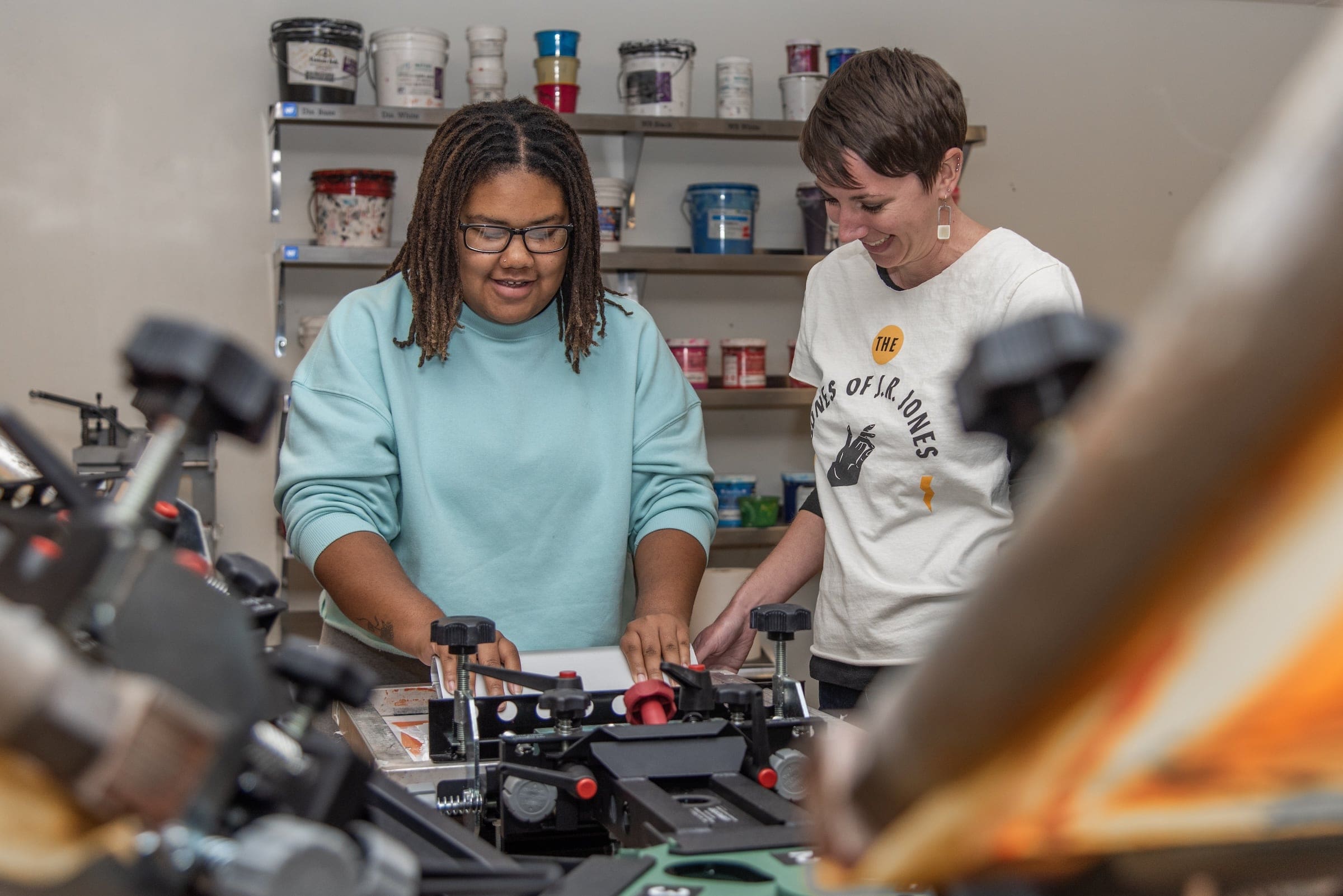
Graphic Communications & Printing Technology
Get started today
About Graphic Communications & Printing Technology
The Graphic Communications and Printing Technology program provides a comprehensive understanding of the printing process and related fields. The student receives training in all major areas, with preparation to enter one of several printing fields, depending on interest and ability.
Graduates with technical and mechanical interests find employment in desktop publishing, pre-press, presswork, and bindery operations. Skills in computer operations, electronics, photography, chemistry, and physics will also be useful in these areas.
Graduates with good English and math skills will find employment in proofreading, estimating, production planning, and sales. Those students with artistic talent may enter layout and design, advertising, or commercial art.
What you’ll learn
- Recognize the major printing processes and their products as well as the advantages of each process.
- Demonstrate the skills needed for entry-level positions (as advanced trainees) in the following areas: layout and design, copy preparation, desktop publishing, film assembly and plate processing, direct-to-plate applications, press operations, and bindery operations.
- Assess personal strengths and limitations in various areas of the graphic arts.
- Demonstrate good work habits: promptness to class, willingness to work, and the ability to accept supervision.
- Demonstrate knowledge of equipment and use appropriate safety precautions.
- Understand the various production departments and the contributions each makes to the finished product.
- Write clear, concise, legible, and accurate technical reports using standard grammatical English.
- Demonstrate skills in basic verbal communication.
- Solve basic math problems related to printing operations.
Sample Job Titles
Design or create graphics to meet specific commercial or promotional needs, such as packaging, displays, or logos. May use a variety of mediums to achieve artistic or decorative effects.
Graphic Designer, Graphic Artist, Designer, Creative Director, Artist, Design Director, Composing Room Supervisor, Creative Manager, Desktop Publisher, Graphic Designer/Production
Soar Agreements
This program enables students to apply certain credits earned in high school to the credits needed for a degree or certificate through Thaddeus Stevens College. The Graphic Communications & Printing Technology degree qualifies for this program – see our SOAR program page for details!
Quick facts
Location
Griscom Education Center, Lobby Level
Type of program
Associate Degree
Job/Salary Outlook
See industry data
Length of program
2 years, 72 credits
Cost of program
$4,500/semester tuition
$3,000 – $3,500/semester housing
$1,850 – $2,335/semester meal plan
Tool List (PDF)

The outcomes speak for themselves
Graduates of this program work in printing, production planning, communications, and graphic design.
83.3%
employment
$37.5K
med. salary
16.7%
cont. education
People of TSCT
Success stories
Program details
Courses
MODEL SCHEDULE FOR GRAPHIC COMMUNICATIONS & PRINTING TECHNOLOGY
Semester 1
- GRPH 116 Introduction to Desktop Publishing (4 credits)
- GRPH 120 Digital Photography (4 credits)
- GRPH 126 Printing Processes I (4 credits)
- CIS 111 Intro to Computer Applications (3 credits)
- MATH 111 Business Math (or higher) (3 credits)
Semester 2
- GRPH 150 Intro to Lithography (3 credits)
- GRPH 155 Intro to Screen Printing (3 credits)
- GRPH 160 Graphic Communications I (3 credits)
- GRPH 165 Multimedia and Web Design (3 credits)
- CIS 211 Microsoft Excel (3 credits)
- ENG 106 English Composition (3 credits)
Semester 3
- GRPH 207 Bindery and Finishing (3 credits)
- GRPH 214 Print Marketing (3 credits)
- GRPH 222 Graphics Communications II (3 credits)
- GRPH 228 Printing Processes II (3 credits)
- Humanities Elective (3 credits)
- ENG 216 Technical Writing OR ENG 221 Public Speaking (3 credits)
Semester 4
- GRPH 258 Advanced Lithography (3 credits)
- GRPH 262 Color Theory (3 credits)
- GRPH 267 Graphics Communications Studio (3 credits)
- GRPH 272 Web Design (3 credits)
- Science Elective (3 credits)
- General Studies Elective (3 credits)
Additional General Education Requirements
- HEAL Elective HEAL 106 or HEAL 111 (1 credit)
Total Credits 72
Click here to download PDF version of Graphic Communications & Printing Technology’s Curriculum
Faculty
Occupational Advisory Committee
The Occupational Advisory Committee (OAC) serves as a vital link between the Program of study and industry, ensuring that the program remains aligned with current workforce needs, technological advancements, and best practices in the field. Composed of employers, educators, and other community members, the committee provides guidance, feedback, and recommendations to enhance the curriculum, instructional methods, and student learning experiences.
Purpose and Responsibilities:
- Curriculum & Industry Alignment
- Workforce Readiness
- Student & Faculty Support
- Internship & Employment Connections
- Accreditation & Program Evaluation
- Facilities & Equipment Recommendations
By fostering a strong relationship between academia and industry, the OAC helps ensure that Thaddeus Stevens College programs maintain the highest standards in CTE (career and technical education).
- Scott Cook, Heidelberg USA
- Yvonne DeSalle, The YGS Group
- William Dougherty, Prestige Color
- Julia Farmer, Intellicor Communications
- Brian Keck, The Standard Group
- Shannon Mosser, ReminderMedia
- Michael Potemra, Intellicor Communications
- Chris Spinelli, Menasha Packaging Co.
- James Tressler, C.P. Bourg Inc.
- Robert Zedaker, Grafika Commercial Printing
Essential Skills Learned
Tasks
- Create designs, concepts, and sample layouts based on knowledge of layout principles and esthetic design concepts.
- Determine size and arrangement of illustrative material and copy, and select style and size of type.
- Confer with clients to discuss and determine layout design.
- Develop graphics and layouts for product illustrations, company logos, and Internet websites.
- Review final layouts and suggest improvements as needed.
- Prepare illustrations or rough sketches of material, discussing them with clients or supervisors and making necessary changes.
- Use computer software to generate new images.
- Key information into computer equipment to create layouts for client or supervisor.
- Maintain archive of images, photos, or previous work products.
- Prepare notes and instructions for workers who assemble and prepare final layouts for printing.
Tools used in this occupation
- Laser printers — Computer laser printers; Wide format printers
- Laptop or Desktop Computers
- Photocopiers — Photocopying equipment
- Scanners
- Digital Cameras
Technology used in this occupation
- Desktop publishing software — Adobe Systems Adobe InDesign
- Graphics or photo imaging software — Adobe Systems Photoshop
- Video creation and editing software — Adobe Premier Pro, AfterEffects and Final Cut Pro
- Web platform development software — AJAX; Cascading Style Sheets CSS; Drupal; Oracle JavaServer Pages JSP
Knowledge
- Design — Knowledge of design techniques, tools, and principles involved in production of precision technical plans, blueprints, drawings, and models.
- Communications and Media — Knowledge of media production, communication, and dissemination techniques and methods. This includes alternative ways to inform and entertain via written, oral, and visual media.
- English Language — Knowledge of the structure and content of the English language including the meaning and spelling of words, rules of composition, and grammar.
- Fine Arts — Knowledge of the theory and techniques required to compose, produce, and perform works of music, dance, visual arts, drama, and sculpture.
- Computers and Electronics — Knowledge of circuit boards, processors, chips, electronic equipment, and computer hardware and software, including applications and programming.
- Customer and Personal Service — Knowledge of principles and processes for providing customer and personal services. This includes customer needs assessment, meeting quality standards for services, and evaluation of customer satisfaction.
- Sales and Marketing — Knowledge of principles and methods for showing, promoting, and selling products or services. This includes marketing strategy and tactics, product demonstration, sales techniques, and sales control systems.
Skills
- Active Listening — Giving full attention to what other people are saying, taking time to understand the points being made, asking questions as appropriate, and not interrupting at inappropriate times.
- Critical Thinking — Using logic and reasoning to identify the strengths and weaknesses of alternative solutions, conclusions or approaches to problems.
- Speaking — Talking to others to convey information effectively.
- Reading Comprehension — Understanding written sentences and paragraphs in work-related documents.
- Active Learning — Understanding the implications of new information for both current and future problem-solving and decision-making.
- Judgment and Decision Making — Considering the relative costs and benefits of potential actions to choose the most appropriate one.
- Operations Analysis — Analyzing needs and product requirements to create a design.
Abilities
- Near Vision — The ability to see details at close range (within a few feet of the observer).
- Oral Comprehension — The ability to listen to and understand information and ideas presented through spoken words and sentences.
- Written Comprehension — The ability to read and understand information and ideas presented in writing.
- Oral Expression — The ability to communicate information and ideas in speaking so others will understand.
- Problem Sensitivity — The ability to tell when something is wrong or is likely to go wrong. It does not involve solving the problem, only recognizing there is a problem.
- Information Ordering — The ability to arrange things or actions in a certain order or pattern according to a specific rule or set of rules (e.g., patterns of numbers, letters, words, pictures, mathematical operations).
- Visualization — The ability to imagine how something will look after it is moved around or when its parts are moved or rearranged.
- Deductive Reasoning — The ability to apply general rules to specific problems to produce answers that make sense.
- Written Expression — The ability to communicate information and ideas in writing so others will understand.
- Inductive Reasoning — The ability to combine pieces of information to form general rules or conclusions (includes finding a relationship among seemingly unrelated events).
- Speech Clarity — The ability to speak clearly so others can understand you.
- Flexibility of Closure — The ability to identify or detect a known pattern (a figure, object, word, or sound) that is hidden in other distracting material.
Work Activities
- Thinking Creatively — Developing, designing, or creating new applications, ideas, relationships, systems, or products, including artistic contributions.
- Getting Information — Observing, receiving, and otherwise obtaining information from all relevant sources.
- Interacting With Computers — Using computers and computer systems (including hardware and software) to program, write software, set up functions, enter data, or process information.
- Updating and Using Relevant Knowledge — Keeping up-to-date technically and applying new knowledge to your job.
- Making Decisions and Solving Problems — Analyzing information and evaluating results to choose the best solution and solve problems.
- Organizing, Planning, and Prioritizing Work — Developing specific goals and plans to prioritize, organize, and accomplish your work.
- Establishing and Maintaining Interpersonal Relationships — Developing constructive and cooperative working relationships with others, and maintaining them over time.
- Communicating with Persons Outside Organization — Communicating with people outside the organization, representing the organization to customers, the public, government, and other external sources. This information can be exchanged in person, in writing, or by telephone or e-mail.
- Communicating with Supervisors, Peers, or Subordinates — Providing information to supervisors, co-workers, and subordinates by telephone, in written form, e-mail, or in person.
- Identifying Objects, Actions, and Events — Identifying information by categorizing, estimating, recognizing differences or similarities, and detecting changes in circumstances or events.
Work Context
- Electronic Mail — 100% responded “Every day.”
- Spend Time Sitting — 92% responded “Continually or almost continually.”
- Face-to-Face Discussions — 69% responded “Every day.”
- Telephone — 69% responded “Every day.”
- Time Pressure — 54% responded “Every day.”
- Importance of Being Exact or Accurate — 58% responded “Extremely important.”
- Work With Work Group or Team — 46% responded “Extremely important.”
- Indoors, Environmentally Controlled — 77% responded “Every day.”
- Structured versus Unstructured Work — 50% responded “Some freedom.”
Interests
- Artistic — Artistic occupations frequently involve working with forms, designs and patterns. They often require self-expression and the work can be done without following a clear set of rules.
- Realistic — Realistic occupations frequently involve work activities that include practical, hands-on problems and solutions. They often deal with plants, animals, and real-world materials like wood, tools, and machinery. Many of the occupations require working outside and do not involve a lot of paperwork or working closely with others.
- Enterprising — Enterprising occupations frequently involve starting up and carrying out projects. These occupations can involve leading people and making many decisions. Sometimes they require risk-taking and often deal with business.
Work Styles
- Attention to Detail — Job requires being careful about detail and thorough in completing work tasks.
- Innovation — Job requires creativity and alternative thinking to develop new ideas for and answers to work-related problems.
- Dependability — Job requires being reliable, responsible, and dependable, and fulfilling obligations.
- Initiative — Job requires a willingness to take on responsibilities and challenges.
- Achievement/Effort — Job requires establishing and maintaining personally challenging achievement goals and exerting effort toward mastering tasks.
- Adaptability/Flexibility — Job requires being open to change (positive or negative) and to considerable variety in the workplace.
- Cooperation — Job requires being pleasant with others on the job and displaying a good-natured, cooperative attitude.
- Persistence — Job requires persistence in the face of obstacles.
- Integrity — Job requires being honest and ethical.
- Independence — Job requires developing one’s own ways of doing things, guiding oneself with little or no supervision, and depending on oneself to get things done.
- Stress Tolerance — Job requires accepting criticism and dealing calmly and effectively with high-stress situations.
Work Values
- Achievement — Occupations that satisfy this work value are results-oriented and allow employees to use their strongest abilities, giving them a feeling of accomplishment. Corresponding needs are Ability Utilization and Achievement.
- Independence — Occupations that satisfy this work value allow employees to work on their own and make decisions. Corresponding needs are Creativity, Responsibility, and Autonomy.
- Recognition — Occupations that satisfy this work value offer advancement, the potential for leadership, and are often considered prestigious. Corresponding needs are Advancement, Authority, Recognition, and Social Status.
Performance Measures
Internal Key Performance Indicators (Sources: Internal data collections, and Post-Graduate Surveys)
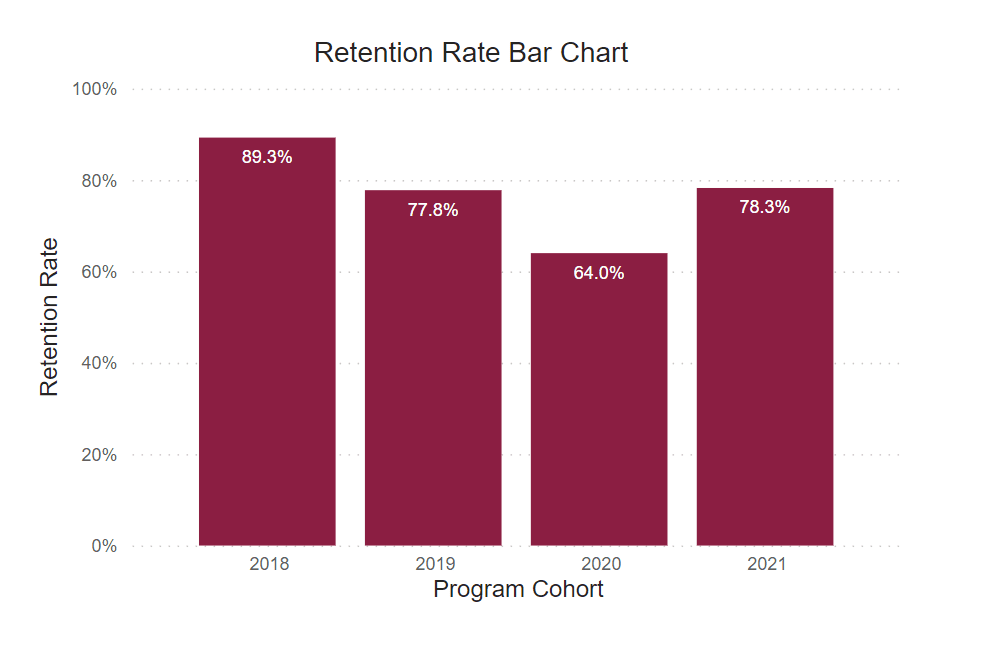
Retention Rate
This rate reflects the continuous term-to-term persistence rate for certificate programs and the fall-to-fall retention rate for associate degree programs.
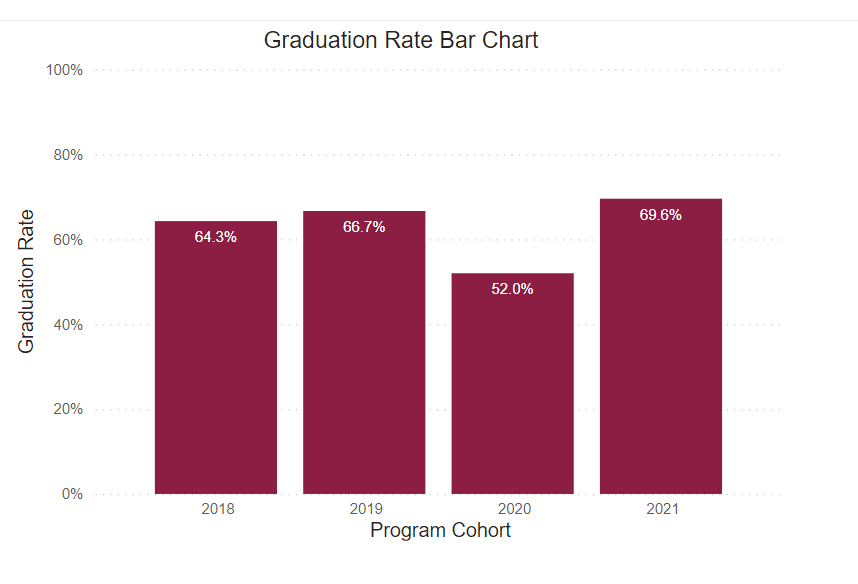
Graduation Rate
This rate reflects the number of freshmen who were officially enrolled in the fall semester and earned a certificate or degree within the expected timeframe.
Post Graduate Survey Response Rate
The post graduate survey is an annual on-line post graduate survey utilized by the college to gather vital information regarding career placement, starting salary, and level of satisfaction.
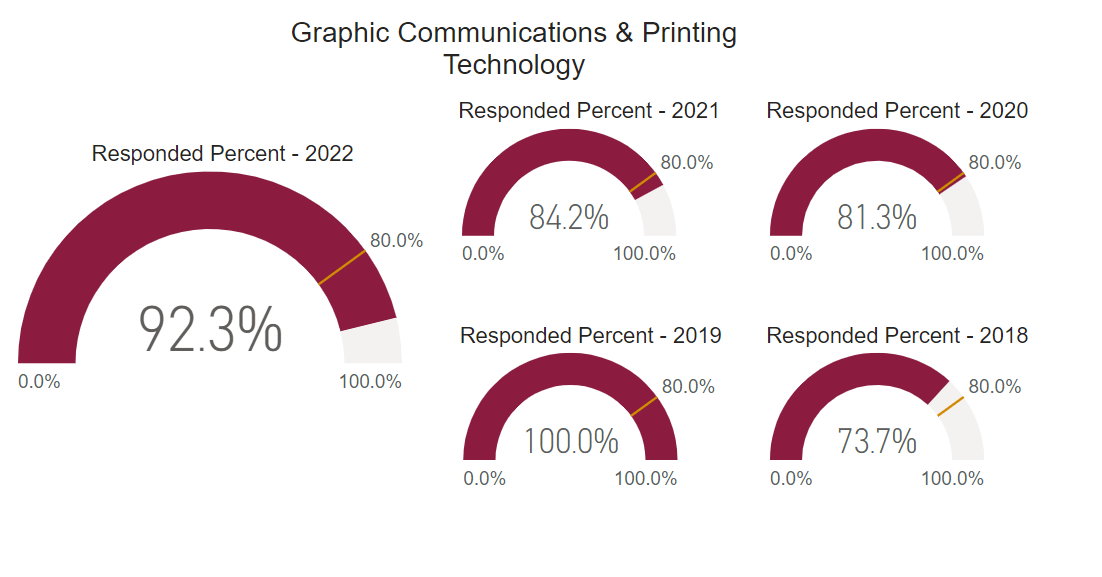
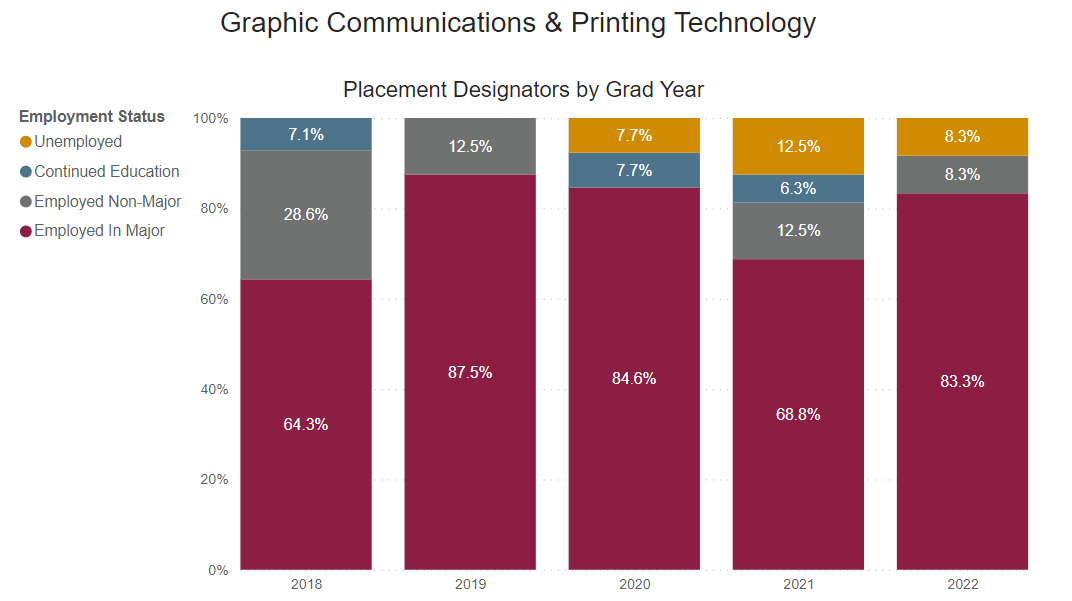
Employed Full Time Outside of Major
Percentage of graduates who reported being employed full-time outside their field of study.
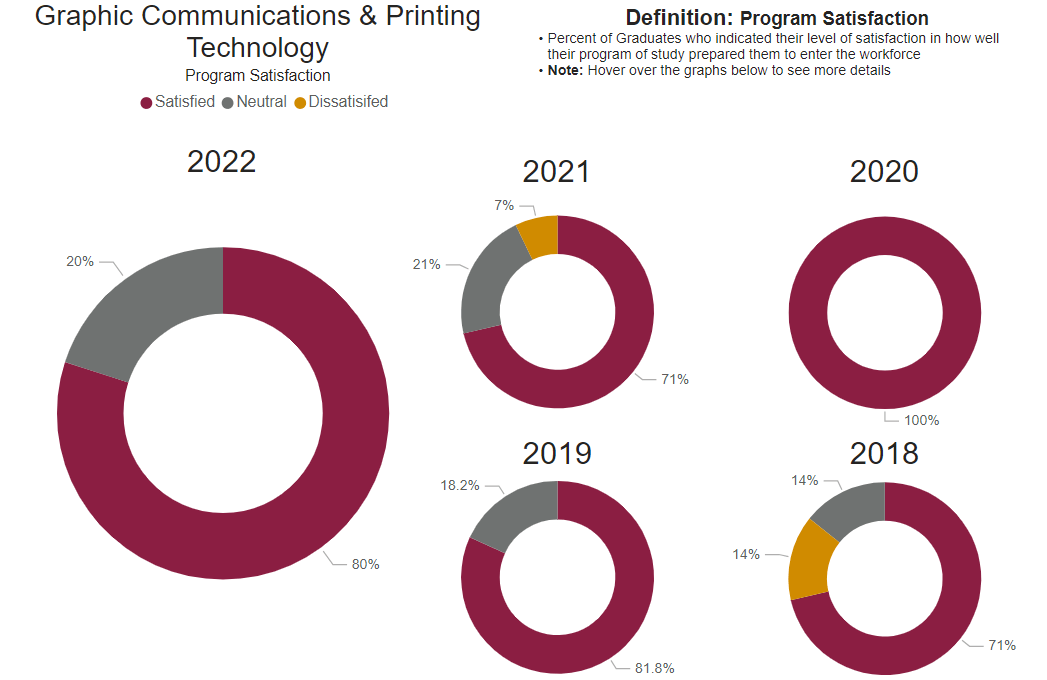
Graduate Satisfaction
This is the median graduate survey response evaluating the level of preparation for workforce entry (based on a 5-Item Likert Scale).

Placement Rate
This is the percent of graduate survey respondents who reported being employed or continued their education on a full-time basis.
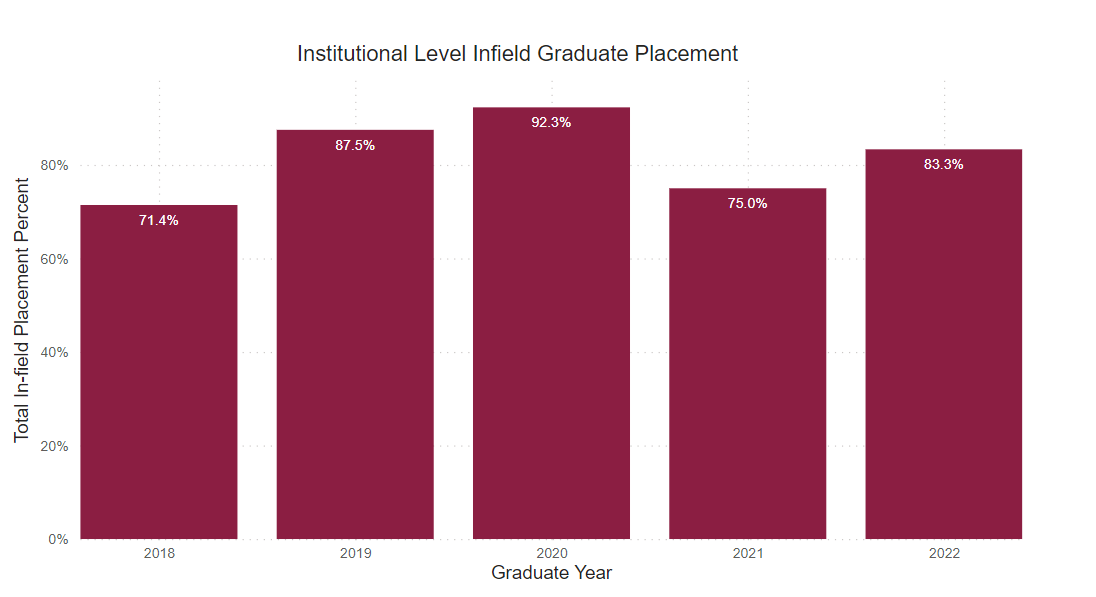
Employed Full Time Within Major
Percentage of graduates who reported being employed full-time within their field of study.

Annual Median Starting Salary
This number is based on the graduate survey response to the request to identify a starting salary from a range of options. This graph shows the median first-year annual salary. All calculations are based on the respondent’s self-reported first-year annual income.
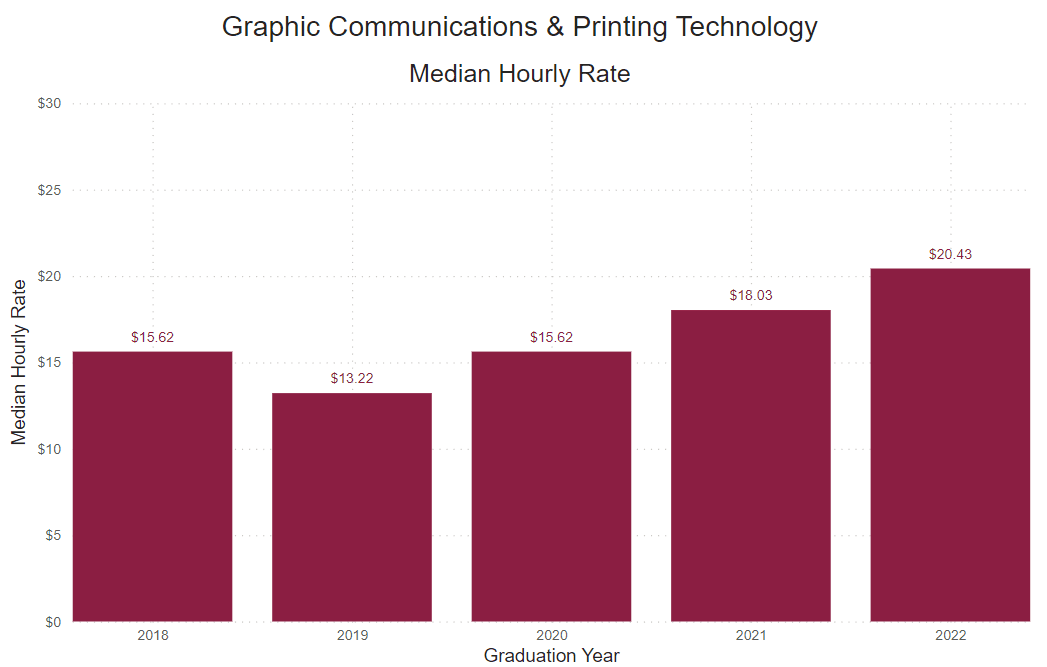
Reported Hourly Rate
This number is determined by dividing the reported median salary by the number of hours in a traditional full-time work week (40), then the number of weeks in a year (52).

Our graduates work with the industry’s best
